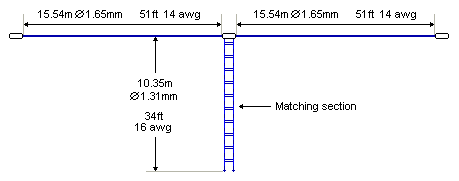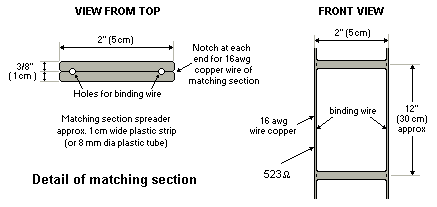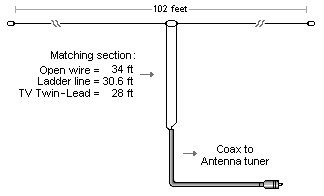G5RV multi-band antenna
The Antenna
The dimensions of the antenna and its matching section are shown in the drawing displayed below. The "flat-top" should, if possible, be horizontal, run in a straight line, and should be erected as high as possible above ground. In describing the theory of operation, it has been assumed that it is generally possible to erect the antenna at an average height of about 10.35m (34 ft), which happens to be the optimum radiation efficiency on 160, 80 and 40m bands for any horizontal type antenna, in practice few amateurs can install masts of the optimum height of half a wavelength on 80 or 40m, and certainly not on 160m.
If, due to limited space available, or to the shape of the garden, it is not possible to accommodate the 31.1m (102 ft) top in a straight line, up to about 3m (10 ft) of the antenna wire at each end may be allowed to hang vertically or at some convenient angle, or be bent in a horizontal plane, with little practical effect upon performance. This is because, for any resonant dipole antenna, most of the effective radiation takes place from the centre two-thirds of its length where the current antinodes are situated. Near to each end of such an antenna, the amplitude of the current standing wave falls rapidly to zero at the outer extremities; consequently, the effective radiation from these parts of the antenna is minimal.
The antenna may also be used in the form of an inverted-V (L). However, it should be borne in mind that, for such a configuration to radiate at maximum efficiency, the included angle at the apex of the L should not be less than about 120° (although many authors consider an opening between 90-120° only); The use of #14 AWG (inner Ø1.63mm) enameled copper wire (stranded) is recommended for all models, although thinner gauges such as #16 (inner Ø1.31mm) or even #18 AWG (inner Ø1.04mm) solid wire can be used. If the wire has to sustain a strong traction, a stranded steel wire of #14 AWG protected with PVC is also suitable.
Electrical tables:
AWG info - Standard Solid Copper - Metric conversion
The Matching Section
This should be, preferably, of open-wire feeder construction for minimum loss. Since this section always carries a standing-wave of current (and voltage) its actual impedance is unimportant. A typical, and very satisfactory, form of construction is shown below. The feeder spreaders may be made of any high-grade plastic strips or tubing; the clear plastic tubing sold for beer or wine siphoning is ideal.
Close-up on the copper ladder constituting the matching section, made of thick copper wire #16 AWG (inner Ø1.31mm).
If it is desired to use 300W ribbon type feeder for this section, it is strongly recommended that the type with "windows" (ladder line) be used because of its much lower loss than that with solid insulation throughout its length, and its relative freedom from the "detuning" effect caused by rain or snow. If this type of feeder is used for the matching section, allowance must be made for its velocity factor in calculating the mechanical length required to resonate as a half-wave section electrically at 14.150 MHz. Since the velocity factor of standard 300W ribbon feeder is 0.82, the mechanical length should be 8.5m (28 ft). However, if 300W ribbon with "windows" is used, its velocity factor will be almost that of open-wire feeder, say 0.90, so its mechanical length should be 9.3m (30.6 ft). This section should hang vertically from the centre of the antenna for at least 6.1m (20 ft) or more if possible. It can then be bent and tight off to a suitable post with a length of nylon or terylene cord so as to be supported at above head-height to the point where, supported by a second post, its lower end is connected to the feeder.
Can we use a coaxial for the matching section ? Louis Varney didn't really extend on this question but we can easily find the benefits and drawbacks of using a coaxial vs. a ladder line. At first sight the coaxial looks indeed more convenient and more resistant. But if both types of lines connected to an antenna tuner can achieve a very low SWR (any value below 2:1 is fine), both systems are not equivalent.
The ladder line is not as easy to install as coaxial. First it must be kept clear of large pieces of metal (at least 10 cm away) to avoid detuning. Unlike coaxial, once installed you cannot bend and shape a ladder line to accomodate your installation. A ladder line doesn't tolerate either repeated flexing as well as coaxial cable or the line may break. At last the built-in antenna tuner of a transceiver is not designed to work with open-wire feed lines. However, a compromise is possible, like using an external balun or an external antenna tuner between the ladder line and the transceiver (one side is attached to the ladder line, the other one receiving a short coaxial that runs to the radio).
But contrarily to coaxial, a ladder line has two big advantages on the coaxial. First, as we told previously a ladder line offers the lowest RF loss on HF frequencies, even when the SWR is relatively high on the feed line to the antenna. Then, connected to an external antenna tuner, a ladder line doesn't require pruning to render the lowest SWR on each operating band. Simply attach your ladder line at your wire antenna and let the antenna tuner worry about providing the lowest SWR for the transceiver. This is simple and efficient ! In other words, a ladder line is much less complex to use that a coaxial; you have only to sit down in front of your radio to go on the air, without squinting at the antenna tuner's SWR meter and twisting several knobs to accomodate the lowest SWR. Using a coaxial you will probably find that you need to readjust the tuner when you go away from the central frequency (over 200 kHz or so) and surely when you will change of band.
So, even if most hams don't use the open-wire for convenience reasons, you can never beat a ladder-line fed dipole in terms of simplicity.
There are at least three ways to make the matching section : using an open wire, a ladder line (standard) or a TV Twin-Lead. Its end is connected to an external tuner linked to an ordinary coax to the radio. The full-size G5RV works on the 160m band too if the station end of the feeder (either balanced or coaxial-type) is strapped and fed by a suitable antenna tuner using a good earth connection or a counterpoise wire. In all cases the length of the matching section must be near 10m and should not be in contact with the ground and kept clear of large pieces of metal (> 10 cm away). Ideally this dipole must be placed over 10m high.
The Feeder
The antenna can be fed by any convenient type of feeder provided always that a suitable type of antenna tuner is used. In the original article describing the G5RV antenna, then in RSGB bulletin November 1966, it was suggested that if coaxial cable feeder was used, a balun (a balanced-to-unbalanced transformer) might be employed to provide the necessary impedance transformation at the base of the matching section. This was because the antenna and its matching section constitute a balanced system, whereas a coaxial cable is an unbalanced type of feeder. However, later experiments and a better understanding of the theory of operation of the balun indicated that such a device was unsuitable because of the highly reactive load it would "see" at the base of the matching or "make-up" section on most HF bands.
It is now known that if a balun is connected to a reactive load presenting a SWR of more than about 2:1, its internal losses increase, resulting in heating of the windings and saturation of its core (if used). In extreme cases, with relatively high power operation, the heat generated due to the power dissipated in the device can cause it to burn out as well as the PL jacks. However, the main reason for not employing a balun in the case of the G5RV antenna is that, unlike an antenna tuner which employs a tuned circuit, the balun cannot compensate for the reactive load condition presented to it by the antenna on most of the HF bands, whereas a suitable type of antenna tuner can do this most effectively and efficiently.
Recent experiments by Louis Varney to determine the importance or otherwise of "unbalance" effects caused by the direct connection of a coaxial feeder to the base of the matching section had a rather surprising result. They proved that, in fact, the HF currents measured at the junction of the inner conductor or the coaxial cable with one side of the (balanced) matching section and at the junction of the outer coaxial conductor (the shield) with the other side of this section are virtually identical on all bands up to 10m, where a slight but inconsequential difference in these currents has been observed. There is, therefore, no need to provide an unbalanced-to-balanced device at this junction when using coaxial feeder.
However, the use of an unbalanced-to-unbalanced type of antenna tuner between the coaxial output of a transceiver and the coaxial feeder is essential because of the reactive condition presented at the station end of this feeder which, on all but the 20m band, will have a fairly high to high SWR on it. This SWR, however, will result in insignificant losses on a good-quality coaxial feeder of reasonable length; say, up to about 21.3m (70 ft). Because it will, inevitably, have standing waves on it, the actual characteristic impedance of the coaxial cable is unimportant, so that either 50W or 80W type can be used.
Another very convenient type of feeder that may be used is 75W Twin-Lead. However, because of the relatively high loss in this type of feeder at frequencies above about 40m, especially when it has a high SWR on it, it is recommended that not more than about 15 to 18m (50 to 60 ft) of this type feeder be used between the base of the matching section and the antenna tuner. Unfortunately the 75W Twin-Lead in the UK is the receiver type; the much less lossy transmitter type is available in continental Europe and in the U.S.A.
Impedance of a ladder line
Assuming that you use round wires, and air dielectric, the impedance is approximatively :
W = 120 ln (2 . D/d)
with W, the impedance in ohm
ln, the natural logarithm
D, the wire spacing, center to center (from 30 to over 150 mm)
d, the wire diameter (from #14 to #18 AWG)
So, to get W ohms for a given wire diameter d, apply the next formula :
D = d.e(W/120)/2
Here are some usual values :
Impedance (W)
D/d
150
200
300
450
600
1.9
2.8
6.2
22
75
By far the most efficient feeder is the "open-wire" type, although it is rarely used. A suitable length of such feeder can be constructed in exactly the same way as that described for the open-wire matching section. If this form of feeder is employed, almost any convenient length may be used from the centre of the antenna right to the antenna tuner (balanced) output terminals. In this case, of course, the matching section becomes an integral part of the feeder. A particularly convenient length of open-wire feeder is 25.6m (84 ft), because such a length permits parallel tuning of the antenna tuner circuit on all bands from 80 to 10m with conveniently located coil taps in the antenna tuner coils for each band, or, where the alternative form of antenna tuner employing a three-gang 500 pF/section variable coupling capacitor is used the optimum loading condition can be achieved for each band. However, this is not a rigid feeder length requirement and almost any length that is mechanically convenient may be used. Since this type of feeder will always carry a standing wave, its characteristic impedance is unimportant, and sharp bends, if necessary, may be used without detriment to its efficiency. It is only when this type of feeder is correctly terminated by a resistive load equal to its characteristic impedance that such bends must be avoided.
Coaxial cable HF choke
Under certain conditions, either due to the inherent "unbalanced-to-balanced" effect caused by the direct connection of a coaxial feeder to the base of the (balanced) matching section, or to pick-up of energy radiated by the antenna, a current may flow on the outside of the coaxial outer conductor. This effect may be considerably reduced, or eliminated, by winding the coaxial cable feeder into a coil of 8 to 10 turns about 15 cm (6") in diameter immediately below the point of connection of the coaxial cable to the base of the matching section. the turns may be taped together or secured by nylon cord. However this construction can become the source of problems during thundery weathers.
Water-proof you said ?
It is important, of course, that the junction of the coaxial cable to the matching section be made thoroughly water-proof and stays dry by any of the accepted methods; binding with several layers of plastic insulating tape or self-amalgamating tape and then applying two or three coats of polyurethane varnish, or totally enclosing the end of the coaxial cable and the connections to the base of the matching section in a sealant such as epoxy resin. At WiMo for example the 4:1 balun coming with their G5RV is designed such a way that it protects the SO-239 connector from the rain when it is hanged in vertical position, the coaxial being screwed over 2 cm inside the balun. However if you work with high power I warmly suggest you to place the balun and its connector inside a small home-maded weatherproof box or, better, to use a small electrical box for oudoor installations so that all connexions stay dry. Even if it rains or if there is fog only once a month in your country, moisture is your worst enemy.
Have fun with G5RV !
How to tune a 40-meter dipole antenna on 15 meters ?
Louis Varney didn't deal with this solution that can be very useful if you want to work with a half-size dipole cut for 7 MHz (about 20m long) on harmonics like the 15m band. But we all know that this wavelength is out of band for phone work (USB) in most ITU Regions (because 7.2 x 3 = 21.6 MHz). By what miracle can we use this dipole on 21 MHz ? The solution is really simple and consists in charging the antenna with a capacitance hat, one on each segment. How to proceed ?
Cut two-60 cm long (2 ft) pieces of thick wire (#12 or #14 house wiring) and solder the ends of each piece together to form 2 loops. Twist the loops in the middle to create a two figure 8s. Solder the twisted centers of your figure 8s to each leg of your dipole at a point about a third of the way from the feed point (position is not critical). Adjust the loop shape and take measurement on 15m band until you reach an acceptable SWR on your working frequency. You SWR on 40m should only see a minor variation.




No comments:
Post a Comment